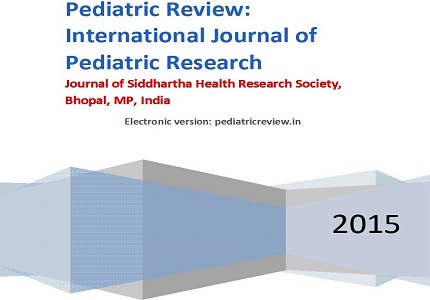Patterns of acute poisoning in children: an epidemiological study from a tertiary care centre
Abstract
Objectives: Acute poisoning in children is an important public health problem worldwide. It is responsible for 0.33% to 7.6% of total admissions in pediatric wards at various hospitals across India. The aim of this study was to assess the pattern of acute poisoning among children (birth to 12 years).
Methods: We retrospectively reviewed the hospital records of all children from birth to 12 years of age with definite history of poisoning during the 3 years period from October 2012 to September 2015.
Results: Of the 203 patients admitted with acute poisoning during the study period, majority (81%) were between 1 to 6 years of age. Male to female ratio was 1.36:1. 68.96% were from rural areas and 31.04% from urban areas. Household products (50.24%), drugs (28.07%), and pesticides and rodenticides (13.30%) were the most frequently implicated agents. Kerosene was major household product implicated. Among drugs, analgesics and antipyretics are commonly implicated. The nature of poisoning was accidental in 98.03% cases. Systems involved in the order of frequency were gastrointestinal, cardiorespiratory, neurological, and others. 89% were discharged after treatment, 5.91% went absconding, 3.44% left against medical advice, and 0.98% expired. Both children who died were 3 years of age and had organophosphorous poisoning.
Conclusion: The pattern of acute poisoning in children noted at our centre was not very different from that observed in other hospital based studies from India. There is a strong need for preventive campaign to reduce the occurrence acute poisoning in children.
Downloads
References
2. Dutta AK, Seth A, Goyal PK et al. Poisoning in children: Indian scenario. Indian J Pediatr1998; 65: 365-70. [PubMed]
3. Kohli U, Kuttait VS, Lodha R, Kabra SK. Profile of Childhood Poisoning at a Tertiary Care Centre in North India. Indian J Pediatr 2008; 75:791-794. [PubMed]
4. Singh S, Singhi S, Sood NK et al. Changing pattern of childhood poisoning (1970 - 1989): Experience of large North Indian hospital. Indian Pediatr 1995; 32: 333-6. [PubMed]
5. Akhtar S, Rani GR, Anezi FA. Risk factors in acute poisoning in children: a retrospective study. Kuwait Med J 2006; 38: 33-6.
6. Shotar AM. Drug poisoning in childhood. Saudi Med J 2005; 26: 1948-50. [PubMed]
7. Basheir A. Hassan, Mohamed G. Siam. Patterns of acute poisoning in childhood in Zagazig, Egypt: An Epidemiological Study.International Scholarly Research Notices, Volume 2014, Article ID 245279, 5 pages. [PubMed]
8. Yang CC et al. Children poisoning in Taiwan. Indian journal of pediatrics, 1997, 64(4):469–83. [PubMed]
9. Andiran N, Sarikayalar F. Pattern of acute poisonings in childhood in Ankara, what has changed in 20 years? Turkish journal of pediatrics, 2004, 46(2):147–52. [PubMed]
10. S K Abbas, S STikmani, N T Siddiqui. Accidental poisoning in children. Journal of Pakistan Medical Association, 2012, 62:331 [PubMed]

Copyright (c) 2015 Author (s). Published by Siddharth Health Research and Social Welfare Society

This work is licensed under a Creative Commons Attribution 4.0 International License.


 OAI - Open Archives Initiative
OAI - Open Archives Initiative


